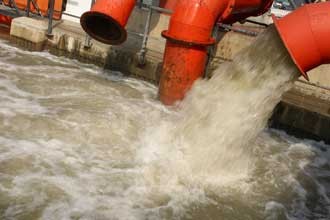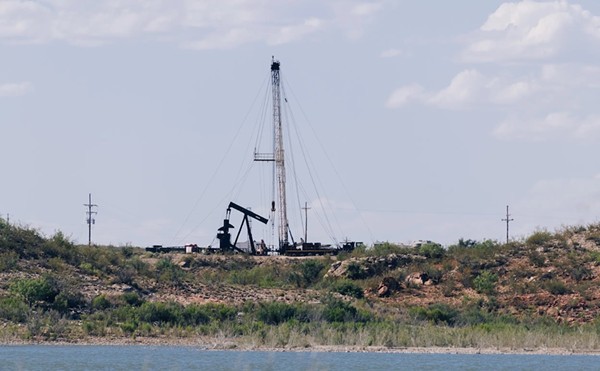Northside population growth overwhelms the wastewater system
Attention: Would Randolph Air Force Base and the cities of Schertz, Universal City, and Live Oak please stop flushing their toilets? Now.
Cibolo Creek Municipal Authority, which processes wastewater generated by those Northeast Side areas, discharged more pollution than allowed by its Clean Water Act permit every month from July 2003 to December 2004, the only Texas facility to achieve that distinction. The pollution, in the form of sewage and ammonia nitrogen, was discharged into Cibolo Creek.
According to a 77-page report, “Troubled Waters: An Analysis of Clean Water Act Compliance,” released in late March by Environment Texas and the Greater Edwards Aquifer Alliance, 35 facilities nationwide, including industries and cities, violated the Clean Water Act every reporting period during the 18-month span.
The environmental groups analyzed data obtained under the Freedom of Information Act, which shows that not only do thousands of facilities in the United States violate the Clean Water Act, but that the amount of pollution they’re pumping into the waterways can be as high as 500 times the legal limit.
Other local facilities with at least one violation include City Public Service, the San Antonio River Authority, and the San Antonio Water System. San Antonio-based Valero Refining reported a permit violation in December 2003 for discharging oil and grease into the Houston Ship Channel. It also logged violations in Corpus Christi and Galveston. Diamond Shamrock, a Valero subsidiary, reported violations for discharging zinc in Live Oak County.
| Sewage by the numbers • Nationally, more than 3,700 major facilities, or 62 percent, exceeded their Clean Water Act permit limits during the reporting period of July 2003-December 2004. While not the laxest state (that dubious honor goes to West Virginia, where 80 percent of the facilities violated their permit limits), Texas is home to five counties with notable violations of the Clean Water Act. • It’s not only the number of violations, but the amount of pollution that wastewater-treatment facilities pour into the state’s waterways that earns Texas its black mark: On 115 occasions, Texas facilities exceeded their Clean Water Act permit limits by 500 percent. Texas ranks second among states that allowed the greatest exceedances of Clean Water Act permits, with 2,043. Ohio ranks first with 2,656. • Of Texas’s 617 major facilities, 348 — or 56 percent — exceeded their permits at least once. • Harris County, Texas, ranks first among U.S. counties with the most facilities that exceeded their Clean Water Act permits at least once. Of Harris County’s 168 major facilities, 99 violated their limits one time or more. • Other Texas counties with significant numbers of facilities exceeding their permit limits are Nueces (16 of 24), Brazoria (14 of 19), Fort Bend (13 of 24), Jefferson (13 of 17), and Galveston (10 of 15). Source: Environment Texas |
While 348 of Texas’s major facilities reported more than 2,000 violations, John Sadlier, director of the enforcement division for the Texas Commission on Environmental Quality, noted that the number of violations represents less than 5 percent of all the recorded discharges æ more than 43,000 æ in the state. He added that since Texas has the most major facilities in the United States 617 it would be more likely that the state would rank higher in permit violations.
In the case of the Cibolo Creek Municipal Authority, a confluence of events has contributed to its wastewater problems: population growth outpacing the treatment plant’s capabilities, stricter limits on ammonia nitrogen, and, ironically, low-flow plumbing.
“They’re getting too many housing starts,” says Annalisa Peace, executive director of GEAA. “They can’t handle the development.”
According to the U.S. Census, Schertz has grown from 4,061 people in 1970, roughly when the CCMA was created, to 18,694 in 2000. In the last decade alone, Schertz’s population has increased 76 percent.
Meanwhile, the state has tightened regulations governing how much ammonia nitrogen, which kills fish, wastewater treatment plants can discharge into waterways, cutting the maximum amount from 20 parts per million to 6 parts per million. In 1997, it decreased the maximum amount by half again, and the CCMA could not meet that standard.
According to TCEQ compliance and penalty data, in July 2002, the agency assessed the CCMA a $10,000 penalty for exceeding its permitted pollution limits; $2,000 of that was deferred in order to settle the matter quickly. The remaining $8,000 was contributed to the Schertz-Cibolo-Universal City Independent School District for a reclaimed-water irrigation project. Those funds were allocated as part of a Supplemental Environmental Project, which allows fines, fees, and penalties for environmental violations to be directed toward environmentally beneficial projects. Through an SEP, a violator can invest penalty dollars in improving the environment, rather than paying into the state’s General Revenue Fund.
| TCEQ: Making it hurt A 2003 report issued by the Texas State Auditor found that the Texas Commission on Environmental Quality was not pursuing polluters vigorously enough, nor collecting adequate penalties from them. Of the 80 TCEQ environmental enforcement cases reviewed, the auditor found that polluters actually benefited $8.6 million from noncompliance æ while only being assessed penalties of $1.7 million. As a result, the TCEQ overhauled its enforcement policies. Here are the numbers of enforcement orders and penalties from 2004-present. Number of enforcement orders Amount of administrative penalties |
According to “Troubled Waters,” more than 100 Texas cities, counties, and towns reported Clean Water Act violations, as did dozens of publicly funded utilities, river authorities, and conservation districts. However, Sadlier said that municipalities are usually “very conscientious” about complying with state and federal regulations. “It’s a question of what’s coming into the plant. Maybe they’re being sent a waste stream they can’t handle.”
That appears to be the case with the CCMA. Ironically, as Schertz protected its water quantity, it inadvertently harmed Cibolo Creek’s water quality. Low-flow toilets and showerheads, and aerated faucets æ new state standards for these fixtures have been in place since 1991 æ decrease the amount of water coming into the plant, but not the amount of waste, which is more highly concentrated and harder to process under the CCMA’s current treatment system.
The CCMA is switching from a filtration system to a process known as “aeration and activate sludge bacteria.” In other words, give bacteria a warm, airy environment and they’ll break down sewage. The plant processes about 4 million gallons of wastewater per day; its capacity is 6.2 million gallons.
“We’re changing the way we treat the water,” said David Dennis, general manager of Cibolo Creek Municipal Authority, “not the capacity.”
The CCMA was created in the early ’70s to serve Randolph Air Force Base, Schertz, Universal City, and Live Oak. Instead of those small communities each running its own wastewater treatment plant, they hooked into the CCMA’s facility. As the Northeast Side grew, CCMA expanded its plant in 1987 and 1992. It upgraded its treatment system in 2000, and the plant is under construction again. The Texas Water Development Board backed $6 million in bonds toward the $12 million in improvements that are expected to be finished in the fall. Another plant expansion is planned in the next decade.
Because of the construction, parts of the plant are down, meaning the CCMA continues to discharge excessive amounts of pollution into Cibolo Creek. “I’m not trying to say we’re not violating, but the process of making a change doesn’t happen overnight,” said Dennis. “We’re doing worse than we were months ago, but the TCEQ understands when you go through the construction process, what the reality is.”
“We can revoke a permit, but then what do we do with the wastewater?” Sadlier said. “Communities aren’t going to stop generating waste.” •
By Lisa Sorg


















